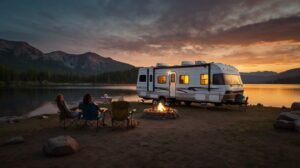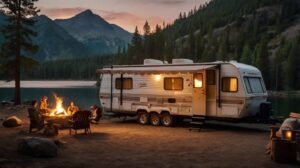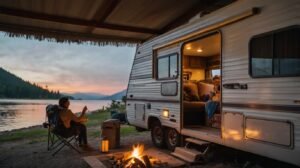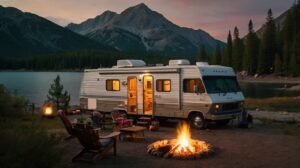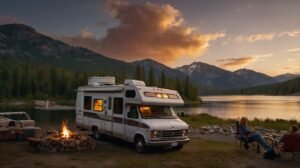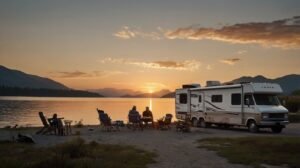
Introduction
Recreational vehicles (RVs) have become increasingly popular in recent years, allowing individuals and families to explore the great outdoors while enjoying the comforts of home. Whether you’re a full-time RVer who has embraced a nomadic lifestyle or an occasional user who loves weekend getaways, understanding the nuances of RV insurance is crucial. In 2025, navigating the insurance landscape can be challenging, especially when it comes to determining the right coverage for your unique needs.
One of the first questions prospective RV owners often ask is whether they need full-timer insurance or occasional use coverage. Full-timer insurance is designed for those who live in their RVs year-round, while occasional use insurance caters to those who use their RVs for short trips or vacations. Both options have distinct features, benefits, and costs, making it essential to understand the differences to find the best coverage for your situation.
In this comprehensive guide, we will explore the key aspects of RV insurance for both full-timers and occasional users. We’ll break down the costs associated with each type of coverage, discuss the various options available, and highlight important considerations to keep in mind when choosing an insurance policy. By the end of this article, you’ll have a clear understanding of how to protect your investment and ensure peace of mind on the road.
For more insights on RV insurance and tips for navigating the insurance landscape, visit zaroraterishta.com. Let’s dive into the world of RV insurance and discover the best coverage options for your needs in 2025.
1. Understanding RV Insurance Basics
Before we delve into the differences between full-timer and occasional use RV insurance, it’s important to understand the fundamentals of RV insurance itself. Here are the key components you need to know:
– **Types of Coverage**: RV insurance typically includes several types of coverage, similar to traditional auto insurance. These include:
– **Liability Coverage**: This is mandatory in most states and covers damages you may cause to others in an accident. It includes bodily injury liability, which pays for medical expenses and lost wages for the other party, and property damage liability, which covers damages to their property.
– **Collision Coverage**: This covers damages to your RV resulting from a collision with another vehicle or object, regardless of fault. Collision coverage is optional for occasional users but is often required for financed RVs.
– **Comprehensive Coverage**: This protects against non-collision-related incidents, such as theft, vandalism, or damage from natural disasters. Comprehensive coverage is crucial for full-timers who may face greater risks while living and traveling in their RVs.
– **Uninsured/Underinsured Motorist Coverage**: This protects you if you’re involved in an accident with a driver who has insufficient insurance or no insurance at all. This coverage is becoming increasingly important as the number of uninsured motorists rises.
– **Personal Effects Coverage**: This covers personal belongings inside your RV, such as electronics, clothing, and camping gear. Full-timers may want to consider higher limits on this coverage, as they often have more belongings in their RVs.
– **State Regulations**: Insurance requirements for RVs vary by state. It’s essential to familiarize yourself with your state’s regulations and minimum coverage requirements to ensure compliance.
– **Risk Assessment**: Insurance companies assess risk based on various factors, including driving history, the type of RV, and how often it is used. Full-timers may face different risk assessments compared to occasional users, which can impact premiums.
– **Premium Calculation Factors**: Several factors influence insurance premiums for RVs, including:
– **Rider Experience**: Your driving experience and history play a significant role in determining premiums. Newer drivers or those with a history of accidents may face higher rates.
– **RV Type and Value**: The make, model, and value of your RV impact insurance costs. Luxury RVs and high-performance models typically come with higher premiums.
– **Mileage and Usage**: How often you drive your RV and the purpose of your trips can affect insurance costs. Full-timers may accumulate more miles, which could lead to higher premiums.
– **Discount Opportunities**: Many insurance companies offer discounts. If you bundle your RV insurance with other policies, complete safety courses, or maintain a good driving record, you may qualify for lower premiums.
Understanding these basic concepts will provide a solid foundation as we explore the differences between full-timer and occasional use RV insurance.
2. Full-Timer RV Insurance
For those who have embraced the full-time RV lifestyle, having the right insurance coverage is crucial. Full-timer RV insurance is specifically designed to meet the unique needs of individuals and families who live in their RVs year-round. Here are some key aspects to consider:
– **Comprehensive Coverage**: Full-timer RV insurance typically includes comprehensive coverage to protect against a wide range of risks. Since full-timers spend a significant amount of time in their RVs, it’s essential to have coverage that safeguards against potential accidents, theft, and damage from weather-related incidents.
– **Liability Coverage**: Liability coverage is a critical component of full-timer insurance. Given that full-timers may encounter various driving conditions and situations, having adequate liability coverage is essential to protect against potential lawsuits and medical expenses resulting from accidents.
– **Personal Effects Coverage**: Full-timers often have more personal belongings in their RVs than occasional users. This makes personal effects coverage particularly important. It covers personal items in the RV, such as clothing, electronics, and camping gear, ensuring that you’re protected in case of theft or damage.
– **Living Expenses Coverage**: Many full-timer policies include coverage for living expenses if your RV becomes uninhabitable due to a covered event. This can help cover costs for alternative accommodations while your RV is being repaired, providing peace of mind during unexpected situations.
– **Higher Premiums**: Full-timer RV insurance generally comes with higher premiums than occasional use policies due to the increased risks associated with living in an RV full-time. Factors such as higher mileage and the potential for more significant claims contribute to the increased costs.
– **Discounts and Savings**: Despite the higher premiums, full-timers can still find ways to save on insurance. Many insurance companies offer discounts for bundling policies, completing safety courses, or maintaining a clean driving record. It’s essential to shop around and compare quotes to find the best coverage at the most affordable price.
– **Choosing the Right Policy**: When selecting a full-timer RV insurance policy, it’s crucial to evaluate your specific needs and lifestyle. Consider factors such as how often you travel, the value of your RV, and the types of coverage that are most important to you. Consulting with an insurance agent who specializes in RV coverage can help you make informed decisions.
– **Comprehensive vs. Actual Cash Value**: When purchasing full-timer insurance, you may have the option to choose between comprehensive coverage and actual cash value (ACV) coverage. Comprehensive coverage pays for the full value of your RV in the event of a total loss, while ACV takes depreciation into account. Understanding these options can impact your premium costs and how much you’ll receive in the event of a claim.
Full-timer RV insurance provides essential protection for those who have chosen to live on the road. By understanding the unique features and benefits of full-timer policies, you can ensure that you have the coverage you need to enjoy your RV lifestyle with confidence.
3. Occasional Use RV Insurance
For those who use their RVs for weekend getaways or vacations, occasional use RV insurance may be a more suitable option. Occasional use policies are designed for individuals who do not live in their RVs full-time but still want to protect their investment during recreational trips. Here’s what you need to know:
– **Basic Coverage**: Occasional use RV insurance typically includes the fundamental coverages such as liability, collision, and comprehensive. This ensures that you’re protected against damages to your RV, as well as damages you may cause to others while driving.
– **Lower Premiums**: Compared to full-timer policies, occasional use insurance generally comes with lower premiums. Since occasional users typically drive their RVs less frequently and may not spend as much time on the road, the risk of accidents is lower, resulting in more affordable rates.
– **Limited Personal Effects Coverage**: While occasional use policies may include some personal effects coverage, it may not be as extensive as what is offered in full-timer policies. If you plan to take valuable items on your trips, consider whether you need additional coverage to protect those belongings.
– **Mileage Considerations**: Insurance companies often consider the number of miles you plan to drive your RV when determining premiums. Occasional users typically drive fewer miles than full-timers, which can contribute to lower costs. However, if you plan to take longer trips, be sure to discuss your mileage expectations with your insurer.
– **Seasonal Policies**: Some insurance companies offer seasonal RV insurance policies, which allow occasional users to obtain coverage only for the months they plan to use their RVs. This can lead to significant savings, as you won’t need to pay for insurance during the off-season when your RV is parked.
– **Coverage Adjustments**: It’s crucial to adjust your coverage based on your plans for the RV. If you’re planning a long trip or a vacation, consider temporarily increasing your coverage for that period to ensure adequate protection.
– **Consultation with an Insurance Agent**: Just like full-timers, occasional users should consult with an insurance agent to determine the best coverage options for their needs. An experienced agent can help you navigate the various policies available and find the right fit for your lifestyle.
– **Understanding Policy Limits**: Be aware of the policy limits on your occasional use insurance. These limits determine how much the insurer will pay in the event of a claim. If you have a higher-value RV or plan to travel with valuable items, you may want to consider increasing your policy limits to ensure adequate protection.
Occasional use RV insurance provides essential protection for those who enjoy recreational trips without living in their RVs year-round. By understanding the features and benefits of occasional use policies, you can make informed decisions that protect your investment and enhance your travel experiences.
4. Cost Comparison: Full-Timer vs. Occasional Use Insurance
When considering RV insurance, one of the most critical factors for many owners is cost. Understanding the differences in premiums between full-time and occasional use insurance can help you make informed decisions. Here’s a breakdown of the costs associated with each type of coverage:
### **Full-Timer Insurance Costs**
– **Average Premiums**: Full-timer RV insurance premiums typically range from $1,200 to $2,500 annually, depending on various factors such as the RV’s value, the coverage limits chosen, and the driver’s experience. Higher-end luxury RVs may see even higher premiums due to their increased value and repair costs.
– **Factors Influencing Costs**: The primary factors influencing full-timer premiums include:
– **RV Value**: The more expensive your RV, the higher your premiums will likely be. Luxury models, motorhomes, and newer RVs generally come with higher coverage costs.
– **Location**: Where you park your RV can impact your insurance costs. Areas with higher crime rates or accident statistics may lead to higher premiums.
– **Mileage**: Full-timers often drive more miles than occasional users, which can increase the likelihood of accidents and claims, leading to higher premiums.
### **Occasional Use Insurance Costs**
– **Average Premiums**: Occasional use RV insurance premiums typically range from $500 to $1,500 annually, making it a more budget-friendly option for those who only use their RVs sporadically.
– **Factors Influencing Costs**: The following factors impact occasional use premiums:
– **Lower Mileage**: Since occasional users drive less frequently, they generally face lower premiums. The reduced risk of accidents contributes to the overall cost savings.
– **Coverage Limits**: Occasional users may choose lower coverage limits compared to full-timers, which can help reduce premiums. However, it’s essential to ensure that you have adequate protection for your RV and personal belongings.
– **Usage Patterns**: The frequency and duration of trips can influence costs. Those who take longer trips may need to adjust their coverage, while those who use their RVs for short weekend getaways may maintain lower premiums.
### **Comparative Summary**
– **Cost Differences**: On average, full-timer insurance tends to be more expensive than occasional use coverage due to the increased risks associated with living in an RV full-time. However, the difference in premiums may not be as significant as one might expect, especially for those who take longer trips or have higher-value RVs.
– **Personalized Quotes**: Since individual circumstances vary widely, obtaining personalized quotes from multiple insurance providers is essential. Insurance companies assess risk differently, and rates can vary significantly based on your specific situation.
– **Discount Opportunities**: Both full-timers and occasional users can benefit from discounts. Bundling policies, completing safety courses, and maintaining a clean driving record can lead to cost savings for both types of coverage.
Understanding the cost differences between full-timer and occasional use RV insurance is crucial for making informed decisions about your insurance needs. By evaluating your lifestyle and coverage requirements, you can find the most suitable option for your situation.
5. Tips for Choosing the Right RV Insurance
Selecting the right RV insurance is essential for protecting your investment and ensuring peace of mind on the road. Here are some practical tips to help you make the best choice for your insurance needs:
– **Assess Your Lifestyle**: Consider how you plan to use your RV. Are you a full-timer who lives in your RV year-round, or do you primarily use it for occasional trips? Understanding your lifestyle will help you determine whether full-timer or occasional use insurance is the better fit.
– **Evaluate Coverage Needs**: Take the time to evaluate the coverage options that are most important to you. For full-timers, comprehensive coverage and personal effects protection may be essential, while occasional users may prioritize basic liability and collision coverage.
– **Shop Around for Quotes**: Don’t settle for the first quote you receive. Take the time to shop around and obtain quotes from multiple insurance providers. Comparing rates and coverage options will help you find the best deal for your specific needs.
– **Consult with Insurance Agents**: Working with an insurance agent who specializes in RV insurance can be extremely beneficial. They can help you navigate the various policies available, explain coverage options, and find the best fit for your lifestyle.
– **Read Customer Reviews**: Before committing to an insurance provider, take the time to read customer reviews and testimonials. Understanding other customers’ experiences can give you insights into the company’s customer service and claims process.
– **Understand the Claims Process**: Familiarize yourself with the claims process for each insurance provider you consider. Knowing how to file a claim and what to expect can save you time and frustration in the event of an accident.
– **Consider Bundling Policies**: If you have other insurance policies, such as auto or home insurance, consider bundling them with your RV insurance. Many companies offer discounts for bundling policies, which can lead to significant savings.
– **Review Policies Annually**: As your circumstances change, it’s essential to review your RV insurance policy annually. Changes in your lifestyle, RV value, and usage patterns may warrant adjustments to your coverage.
– **Utilize Technology**: Many insurance providers offer mobile apps or online tools that allow you to manage your policy, file claims, and access important documents easily. Utilizing these tools can enhance your experience and streamline the process of handling your insurance.
– **Stay Informed About Industry Changes**: The insurance landscape is continually evolving, with new policies and regulations being introduced. Staying informed about industry changes can help you make better decisions about your coverage options.
By following these tips, you can make informed decisions about your RV insurance and find the coverage that best fits your needs.
FAQs About RV Insurance: Full-Timer vs. Occasional Use (2025)
1. What’s the difference between full-timer and occasional use RV insurance?
Full-timer insurance is designed for those who live in their RV year-round, offering higher liability, personal belongings, and living expense coverage. Occasional use insurance is for recreational trips and typically has lower premiums.
2. Do I need full-time insurance if I only live in my RV part of the year?
If your RV is your primary residence (even seasonally), you may need full-timer insurance. If you only use it for vacations, occasional use coverage is likely sufficient.
3. How much does full-timer RV insurance cost compared to occasional use?
Full-timer insurance averages $1,200–$2,500/year, while occasional use ranges $500–$1,500/year due to lower risk and mileage.
4. Does RV insurance cover personal belongings inside the vehicle?
Yes, but full-timer policies usually offer higher personal effects coverage since full-time RVers carry more belongings.
5. Can I get temporary or seasonal RV insurance?
Yes! Some insurers offer seasonal policies for occasional users, allowing coverage only during active travel months.
6. Will my auto insurance cover my RV?
Standard auto insurance does not fully cover RVs. You need a specialized RV policy for proper liability, collision, and comprehensive protection.
7. What factors affect my RV insurance rates?
-
RV type (Class A, B, C, travel trailer)
-
Usage (full-time vs. occasional)
-
Driving history
-
Storage location (secure lot vs. roadside)
-
Deductible choices
8. Does full-timer insurance include roadside assistance?
Many policies include roadside assistance, but check for towing limits, emergency lodging, and trip interruption coverage.
9. Can I bundle RV insurance with my home or auto policy?
Yes! Many insurers offer multi-policy discounts if you bundle RV insurance with home or auto coverage.
10. What happens if my RV is totaled—will insurance pay full value?
It depends on your policy:
-
Actual Cash Value (ACV) – Pays current market value (minus depreciation).
-
Agreed Value/Total Loss Replacement – Pays a pre-set amount or replaces with a new RV (best for newer models).
6. Conclusion
In conclusion, understanding the differences between full-timer and occasional use RV insurance is crucial for protecting your investment and enjoying your RV lifestyle. Each type of coverage has its unique features, benefits, and costs, making it essential to evaluate your individual needs and circumstances.
Full-timer RV insurance provides comprehensive protection for those who live in their RVs year-round, while occasional use insurance caters to those who use their vehicles for recreational trips. By assessing your lifestyle, evaluating coverage needs, and shopping around for quotes, you can make informed decisions that suit your situation.
As you navigate the complexities of RV insurance, remember to stay informed about changes in the industry and seek advice from professionals when needed. For more insights on RV insurance and tips for navigating the insurance landscape, visit zaroraterishta.com. Equip yourself with the knowledge and tools necessary to protect your investment and enjoy your adventures on the road with confidence.

